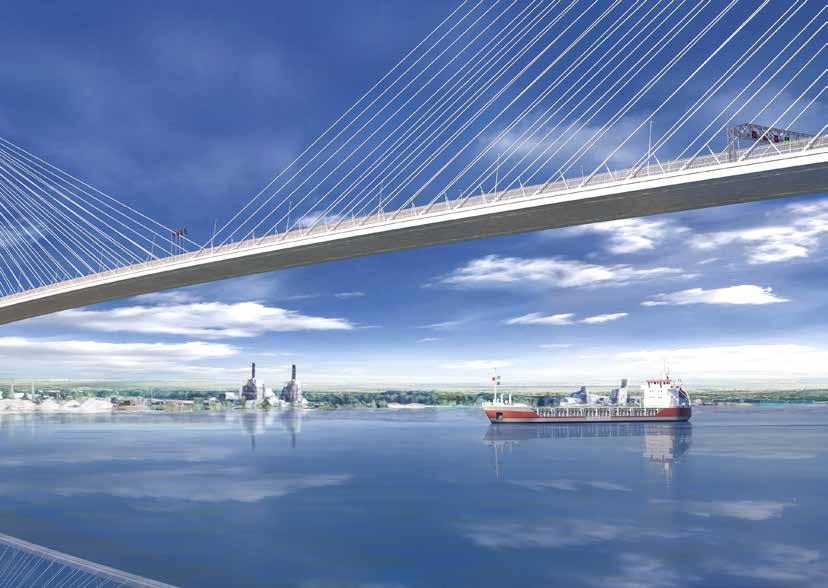
4 minute read
New Windsor-Detroit Bridge provides opportunities for marine sector
NEW WINDSORDETROIT BRIDGE provides opportunities for marine sector
BY BRENT FREDERICK
The Gordie Howe International Bridge project, the largest infrastructure project along the Canada-U.S. border, is providing opportunities for the marine sector to handle greater volumes of cargo as well as the development of logistics and trade hubs for international traffic. The $5.7-billion project includes a new bridge between Windsor and Detroit and ports of entry (POEs) on both sides of the border. The bridge will deliver needed transportation improvements and handle expected growth through the trade corridor, the busiest commercial land border crossing between Canada and the U.S., accounting for more than 25 per cent of the total bilateral trade between the two countries.
A considerable amount of construction aggregate required for the project already has been delivered by ship through the Great Lakes ports of Windsor and Detroit, says Mark Butler, the Windsor-Detroit Bridge Authority’s Director of Communications.
“As part of our logistics plan, we seek the most efficient, economical and sustainable way to transport materials to our construction sites, both in Canada and the United States,” Butler says. “The location of the source of materials or parts helps us decide whether railroad, truck transportation, or marine transportation provides the most economical and efficient way to deliver materials.”
“Another factor is quantity and size of materials. For large quantities of
26 material, like aggregate, or large-sized items, such as pre-cast concrete, pre-fabricated elements, and other major components, marine transportation can be the most-efficient way to get materials here.”
The Windsor-Detroit Bridge Authority (WDBA), a Crown corporation, is responsible for the delivery of the bridge through a public-private partnership. Bridging North America is WDBA’s privatesector partner. The six-lane bridge will be 2.5 kilometres long, have a clear span of 853 metres – the longest main span of any cable-stayed bridge in North America, and directly connect Highway 401 in Windsor with I-75 in Detroit. There will be dedicated truck lanes on the bridge and in the Ports of Entries.
Port Windsor has handled hundreds of thousands of tonnes of construction aggregate needed to create a sufficient base for the 53-hectare Canadian POE, the largest plaza of any Canadian border crossing with the U.S. The port is expecting to handle more aggregate for the bridge project along with items such as steel materials and cable, pre-fabricated components, large construction equipment and heavy machinery, and construction materials and concrete. The amounts will be “pretty significant,” says Steve Salmons, President and CEO of Port Windsor.

Salmons says marine is a sound economic and feasible transportation mode for the items required for the project. “Much of the equipment is too large to move by rail or by highway, so invariably it is going to come by water and through our port terminal. We’re going to do everything we can to make sure we get every bit of that business,” he says.
Opportunity for logistics hub While the entire Windsor-Essex region will benefit from the project through 2025, when the bridge is scheduled to open, the real question, Salmons says, is, “What are we going to do about it when it does open? Will this bridge be an economic bypass or an economic lifeline to this community?
27 “We are uniquely situated in North America, at the nexus of the largest trading relationship and the largest transportation linkage between Canada and the U.S. More traffic, more volume and more dollars flow through Port Windsor, its current bridge, rail and vehicle tunnels and ferries than all other crossings in Ontario (and any other crossing in Canada). Our marine, rail and road transportation systems are all connected. We’re now getting this new six-lane super bridge that connects the Canadian economic lifeline called the 401 to every major highway and market in the Central U.S. How can that not be anything but an advantage and a massive opportunity for us?
“At some point there must be an opportunity for a hub of logistics
Artist rendering of six-lane bridge that will have the longest main span of any cable-stayed bridge in North America. Source: WDBA

activities, and a hub that is not servicing just the economy or industry of WindsorEssex, but that of Central North America. That’s what the port has seized.”
Port Windsor taking the lead Indeed, Port Windsor is leading a roundtable discussion that is examining how the region can best benefit from the new bridge and become a chief gateway for international trade. “If we don’t ask this question in 2020, seek the answers and use the collective wisdom and genius of this community, in 2025 it will be too late,” Salmons says. “We will wake up and say, ‘Wow, we should’ve thought about this. We should’ve been doing something while they were building this bridge.’ “I’m proud that our board and port authority has taken the lead – the initiative on this in the community. We’re getting overwhelming enthusiasm and agreement that this is what we need to do, and we need to do it now. Because once the bridge opens, logistics patterns and logistics systems will become set and entrenched, and they’re very difficult to break. We all know that if there’s an interruption in a major transportation link, shippers find alternatives. They are very difficult to pull back to their original distribution system.”
The roundtable comprises community and business leaders, including transportation industry representatives, plant owners and people who understand the international movement of goods and the “ground game of logistics,” Salmons says. n










